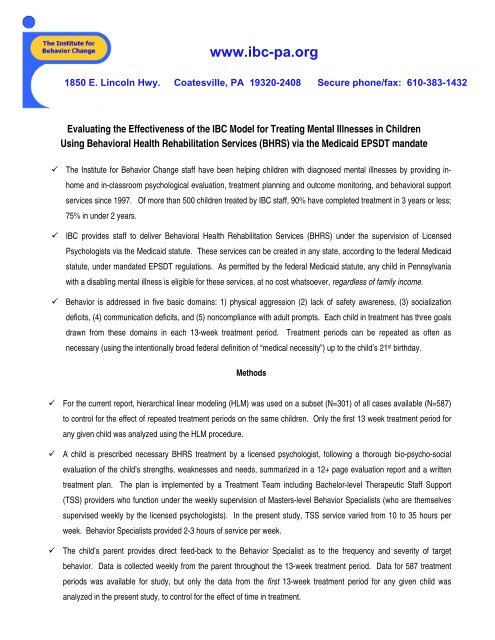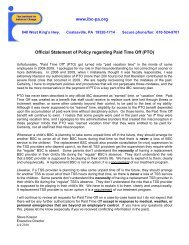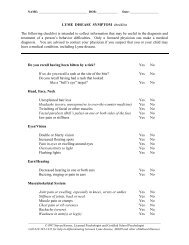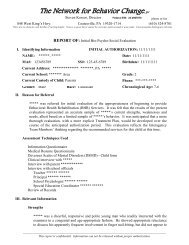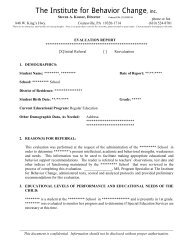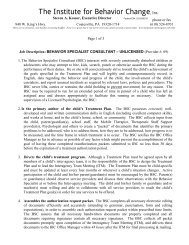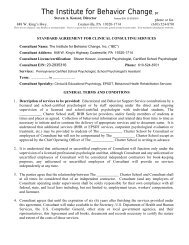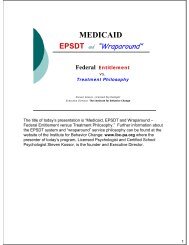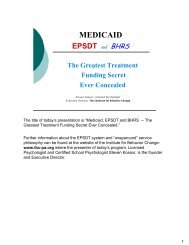Evaluating the Effectiveness of the IBC Model for Treating Mental ...
Evaluating the Effectiveness of the IBC Model for Treating Mental ...
Evaluating the Effectiveness of the IBC Model for Treating Mental ...
Create successful ePaper yourself
Turn your PDF publications into a flip-book with our unique Google optimized e-Paper software.
www.ibc-pa.org<br />
1850 E. Lincoln Hwy. Coatesville, PA 19320-2408 Secure phone/fax: 610-383-1432<br />
<strong>Evaluating</strong> <strong>the</strong> <strong>Effectiveness</strong> <strong>of</strong> <strong>the</strong> <strong>IBC</strong> <strong>Model</strong> <strong>for</strong> <strong>Treating</strong> <strong>Mental</strong> Illnesses in Children<br />
Using Behavioral Health Rehabilitation Services (BHRS) via <strong>the</strong> Medicaid EPSDT mandate<br />
The Institute <strong>for</strong> Behavior Change staff have been helping children with diagnosed mental illnesses by providing inhome<br />
and in-classroom psychological evaluation, treatment planning and outcome monitoring, and behavioral support<br />
services since 1997. Of more than 500 children treated by <strong>IBC</strong> staff, 90% have completed treatment in 3 years or less;<br />
75% in under 2 years.<br />
<strong>IBC</strong> provides staff to deliver Behavioral Health Rehabilitation Services (BHRS) under <strong>the</strong> supervision <strong>of</strong> Licensed<br />
Psychologists via <strong>the</strong> Medicaid statute. These services can be created in any state, according to <strong>the</strong> federal Medicaid<br />
statute, under mandated EPSDT regulations. As permitted by <strong>the</strong> federal Medicaid statute, any child in Pennsylvania<br />
with a disabling mental illness is eligible <strong>for</strong> <strong>the</strong>se services, at no cost whatsoever, regardless <strong>of</strong> family income.<br />
Behavior is addressed in five basic domains: 1) physical aggression (2) lack <strong>of</strong> safety awareness, (3) socialization<br />
deficits, (4) communication deficits, and (5) noncompliance with adult prompts. Each child in treatment has three goals<br />
drawn from <strong>the</strong>se domains in each 13-week treatment period. Treatment periods can be repeated as <strong>of</strong>ten as<br />
necessary (using <strong>the</strong> intentionally broad federal definition <strong>of</strong> “medical necessity”) up to <strong>the</strong> child’s 21 st birthday.<br />
Methods<br />
For <strong>the</strong> current report, hierarchical linear modeling (HLM) was used on a subset (N=301) <strong>of</strong> all cases available (N=587)<br />
to control <strong>for</strong> <strong>the</strong> effect <strong>of</strong> repeated treatment periods on <strong>the</strong> same children. Only <strong>the</strong> first 13 week treatment period <strong>for</strong><br />
any given child was analyzed using <strong>the</strong> HLM procedure.<br />
A child is prescribed necessary BHRS treatment by a licensed psychologist, following a thorough bio-psycho-social<br />
evaluation <strong>of</strong> <strong>the</strong> child’s strengths, weaknesses and needs, summarized in a 12+ page evaluation report and a written<br />
treatment plan. The plan is implemented by a Treatment Team including Bachelor-level Therapeutic Staff Support<br />
(TSS) providers who function under <strong>the</strong> weekly supervision <strong>of</strong> Masters-level Behavior Specialists (who are <strong>the</strong>mselves<br />
supervised weekly by <strong>the</strong> licensed psychologists). In <strong>the</strong> present study, TSS service varied from 10 to 35 hours per<br />
week. Behavior Specialists provided 2-3 hours <strong>of</strong> service per week.<br />
The child’s parent provides direct feed-back to <strong>the</strong> Behavior Specialist as to <strong>the</strong> frequency and severity <strong>of</strong> target<br />
behavior. Data is collected weekly from <strong>the</strong> parent throughout <strong>the</strong> 13-week treatment period. Data <strong>for</strong> 587 treatment<br />
periods was available <strong>for</strong> study, but only <strong>the</strong> data from <strong>the</strong> first 13-week treatment period <strong>for</strong> any given child was<br />
analyzed in <strong>the</strong> present study, to control <strong>for</strong> <strong>the</strong> effect <strong>of</strong> time in treatment.
Sample<br />
HLM analyses excluded records in which any one outcome was targeted <strong>for</strong> more than <strong>the</strong> first time in <strong>the</strong> same child<br />
(n=301). The subsample had <strong>the</strong> following demographic characteristics:<br />
301 treatment periods (<strong>the</strong> first 13-week BHRS treatment experience <strong>for</strong> all subjects) were analyzed, children ranging<br />
in age from 3-17<br />
• 13.6% - Ages 3-4<br />
• 47.6% - Ages 5-8<br />
• 25.6% - Ages 9-12<br />
• 13.0% - Ages 13-17<br />
The sample included children <strong>of</strong> various backgrounds including Caucasian (79.2%), Asian (10%), and African<br />
American, Bi-racial, and Latino/a (10.8%). The latter group was <strong>for</strong>med due to <strong>the</strong> small sample size.<br />
The diagnoses <strong>of</strong> <strong>the</strong> children included Autistic Spectrum Disorders (47.3%), ADHD (26.8%), Mood Disorder, (11.4%),<br />
and Behavioral Disorders (14.4%)<br />
This was <strong>the</strong> first outpatient treatment experience <strong>for</strong> 72% <strong>of</strong> <strong>the</strong> children; 28% had received outpatient psycho<strong>the</strong>rapy<br />
previously. 12% had received inpatient treatment <strong>for</strong> mental illness symptoms in <strong>the</strong> past.<br />
Results<br />
At least 15% net change in target behavior was shown by <strong>the</strong> following percentages <strong>of</strong> children, after just 13 weeks <strong>of</strong><br />
treatment.<br />
Target Behavior Domain Improved Improved or Stabilized<br />
Communication deficits 51% 66%<br />
Socialization deficits 49% 62%<br />
Physical Aggression 47% 68%<br />
Non-compliance 36% 57%<br />
Safety Awareness 27% 58%<br />
Of <strong>the</strong> 587 treatment records that were made available, about half included multiple treatment periods <strong>for</strong> <strong>the</strong> same child..<br />
To control <strong>for</strong> <strong>the</strong> variable <strong>of</strong> time in treatment, a subsample <strong>of</strong> 301 records was selected <strong>for</strong> analysis by <strong>the</strong> University <strong>of</strong><br />
North Carolina researchers because each represented a child’s initial treatment period <strong>of</strong> 13 weeks.<br />
Behavior improved or stabilized in between 58% and 68% <strong>of</strong> <strong>the</strong> cases receiving BHRS treatment implemented by <strong>the</strong><br />
staff <strong>of</strong> <strong>the</strong> Institute <strong>for</strong> Behavior Change in just 13 weeks.
Charts <strong>for</strong> <strong>the</strong> top 3 improvement areas in <strong>the</strong> first 13 weeks <strong>of</strong> treatment:<br />
HLM Analyses <strong>of</strong> <strong>the</strong> subsample (N=301)<br />
Hierarchical linear modeling (HLM) was used to determine if <strong>the</strong> <strong>IBC</strong> treatments were related to improvements in client<br />
behavior.<br />
o Although a control group is necessary in order to claim that treatment caused behavior change in <strong>the</strong> children,<br />
HLM establishes that decreases in target behaviors occurred during <strong>the</strong> <strong>IBC</strong> treatment period.<br />
o HLM was chosen <strong>for</strong> <strong>the</strong> analysis because <strong>the</strong> data have a nested, multilevel structure, with time points nested<br />
within individual children. This process ensures that <strong>the</strong> violation <strong>of</strong> <strong>the</strong> assumption that observations are<br />
independent <strong>of</strong> each o<strong>the</strong>r is accounted <strong>for</strong> (Guo, 2005).<br />
Analyses confirmed <strong>the</strong> hypo<strong>the</strong>sis that increased time in treatment was significantly related (p
Discussion<br />
Treatment provided by <strong>IBC</strong> staff is positively related to a decrease in identified target behaviors (level one predictors).<br />
Improvements occurred in all five domains over <strong>the</strong> 13 week period. Considering that <strong>the</strong> first 13 weeks <strong>of</strong> treatment<br />
<strong>of</strong>ten show <strong>the</strong> slowest rate <strong>of</strong> improvement (as <strong>the</strong> child adjusts to changes imposed by <strong>the</strong> treatment plan, while rapport<br />
with <strong>the</strong> treatment team is being established, and <strong>the</strong> common “extinction burst” phenomena occurs), <strong>the</strong> rates <strong>of</strong><br />
improvement shown are remarkable.<br />
Regarding physical aggression, age and gender influenced outcomes with boys and younger children more likely to show<br />
improvement within <strong>the</strong> first 13 weeks <strong>of</strong> treatment.<br />
Regarding safety awareness, younger children are more likely to improve in <strong>the</strong> first 13 weeks <strong>of</strong> treatment than older<br />
children.<br />
Among Medicaid recipients, BHRS is received disproportionately by Caucasian children, suggesting inadequate<br />
dissemination <strong>of</strong> in<strong>for</strong>mation about <strong>the</strong> availability <strong>of</strong> BHRS to families <strong>of</strong> children eligible <strong>for</strong> Medicaid.<br />
More research is planned to investigate <strong>the</strong> effects <strong>of</strong> BHRS on children, including analyses <strong>of</strong> successive treatment<br />
programs <strong>for</strong> <strong>the</strong> same child over periods <strong>of</strong> 1 to 2 years.<br />
___________________________________________________________________________________________<br />
The research cited in this monograph was conducted by Dr. Natasha K. Bowen and Erica L. Richman at <strong>the</strong><br />
University <strong>of</strong> North Carolina at Chapel Hill. Assistance with graphics and presentation <strong>of</strong> research findings was<br />
provided by William LaValle and Mat<strong>the</strong>w Mauriello <strong>of</strong> <strong>the</strong> Institute <strong>for</strong> Behavior Change. Fur<strong>the</strong>r research is<br />
underway. Visit www.treatmentplansthatworked.com to obtain more than 150 <strong>of</strong> <strong>the</strong> actual Treatment Plans<br />
used by <strong>IBC</strong> staff to produce <strong>the</strong> data <strong>for</strong> this study.<br />
Contact:<br />
Steven Kossor<br />
Licensed Psychologist, Certified School Psychologist<br />
Executive Director, The Institute <strong>for</strong> Behavior Change<br />
sakossor@ibc-pa.org 610-212-0738<br />
Suggested Readings (a comprehensive literature review identified just two articles addressing BHRS explicitly)<br />
T<strong>of</strong>falo, D.A.D. (2000). An investigation <strong>of</strong> treatment integrity and outcomes in wraparound services.<br />
Journal <strong>of</strong> Child and Family Studies, 9, 351-361.<br />
This article describes a study <strong>of</strong> 28 children receiving BHRS (mislabeled “wraparound”) in rural<br />
Pennsylvania. It aimed to find a relationship between adherence to prescribed levels <strong>of</strong> service hours and<br />
improvement in client functioning. Significant improvement in client functioning was evidenced after six<br />
months <strong>of</strong> BHRS delivery, whe<strong>the</strong>r or not <strong>the</strong> client received all <strong>of</strong> <strong>the</strong> “prescribed” hours <strong>of</strong> service.<br />
Bugaj, S.J., & Manning, R.L. (2002). Suggestions <strong>for</strong> improving <strong>the</strong> delivery <strong>of</strong> Therapeutic Staff Support<br />
in <strong>the</strong> public schools. Journal <strong>of</strong> <strong>Mental</strong> Health Counseling, 24, 88-93.<br />
This article outlines procedures <strong>for</strong> facilitating collaboration between BHRS agencies employing TSS<br />
providers in <strong>the</strong> school setting. Procedures, school organization, and role <strong>of</strong> pr<strong>of</strong>essionals in <strong>the</strong> school<br />
setting are summarized. No evaluation <strong>of</strong> BHRS efficacy or efficiency was reported.<br />
Permission to copy and distribute this monograph is granted, provided that no changes to content are made.


